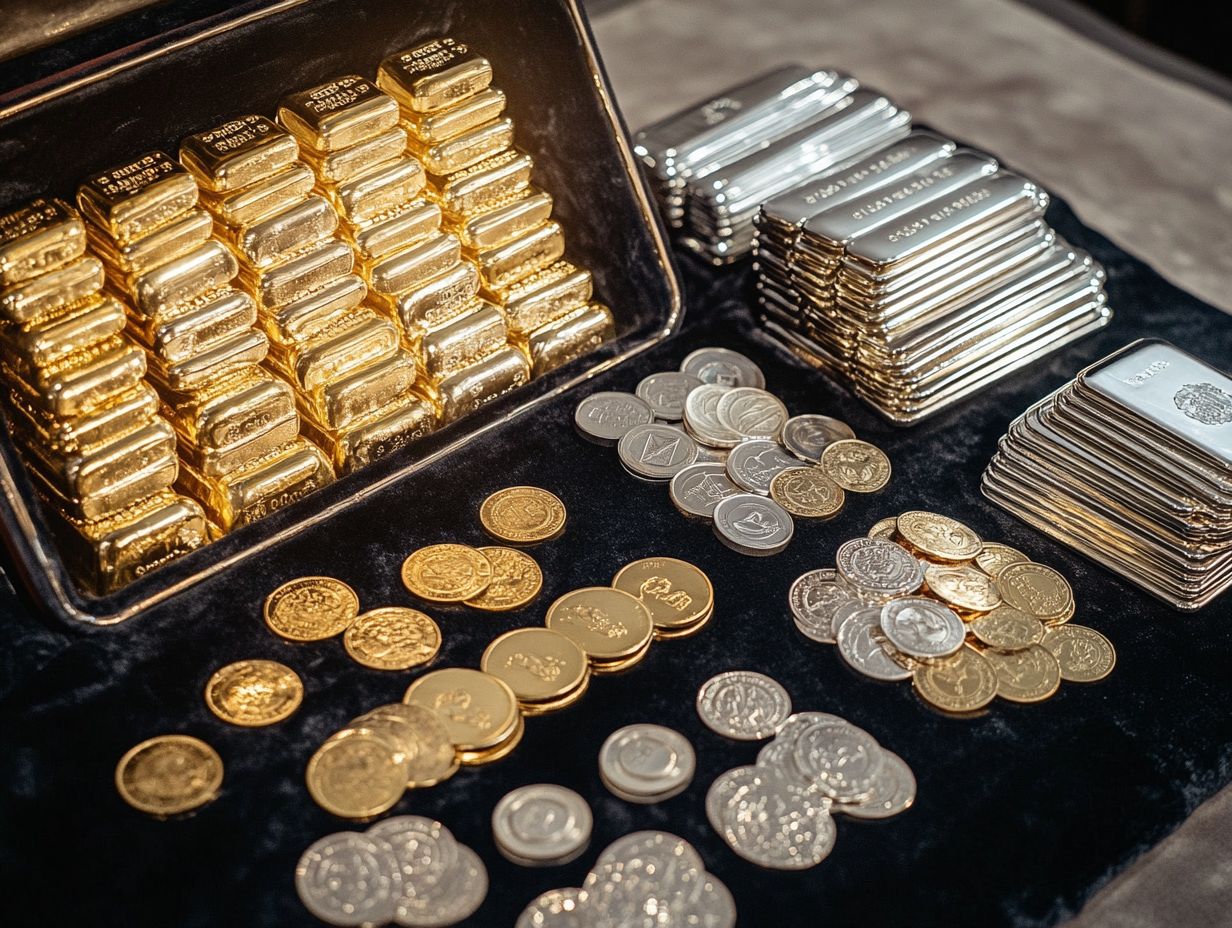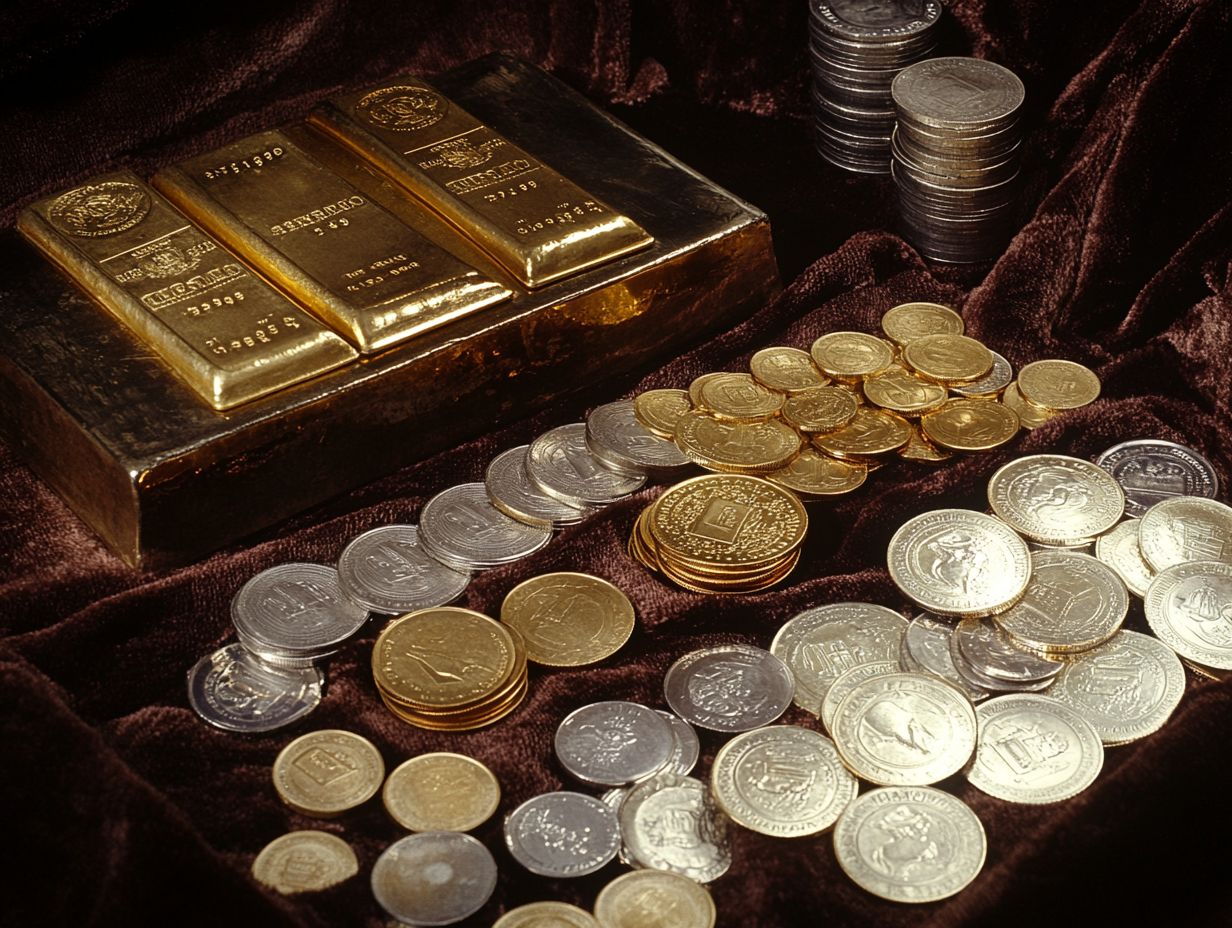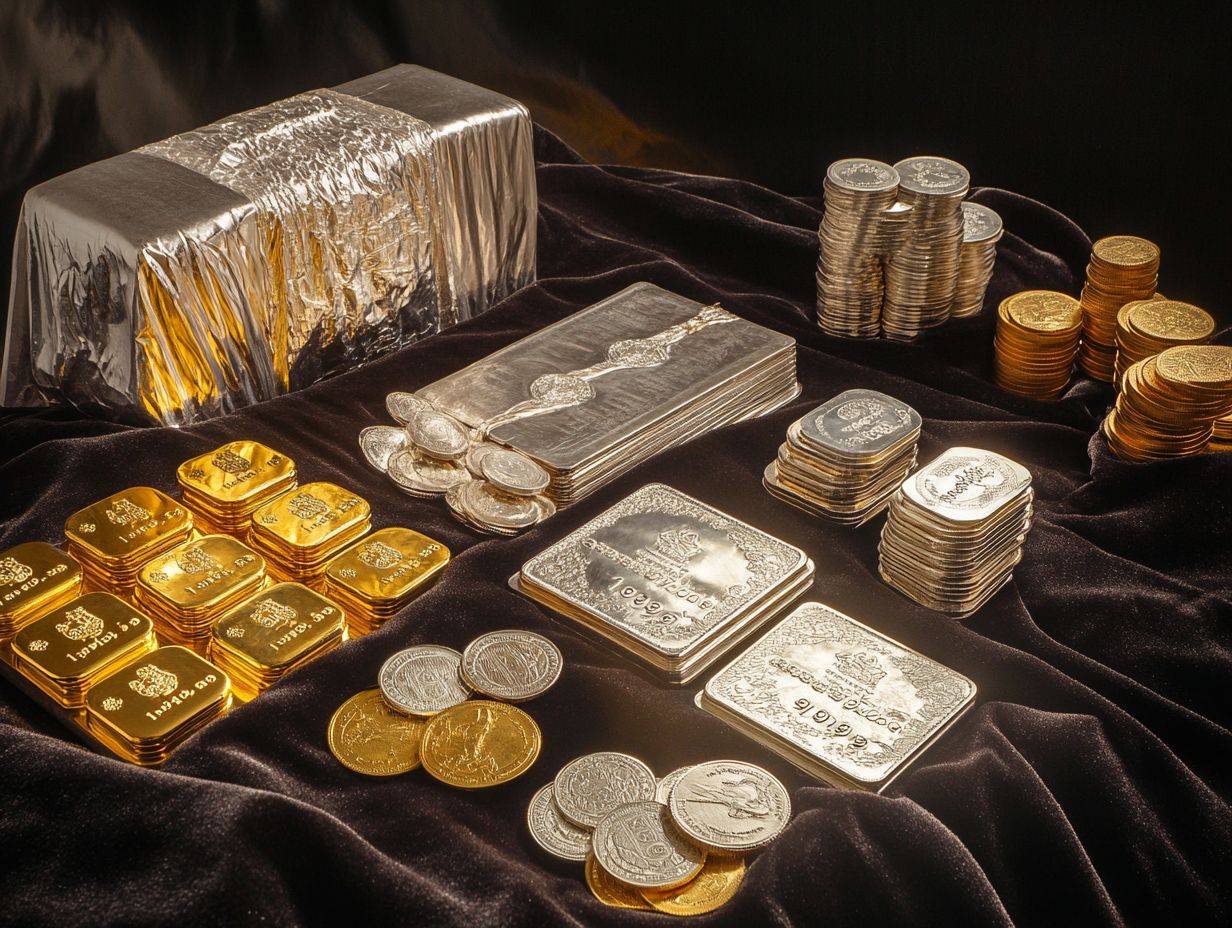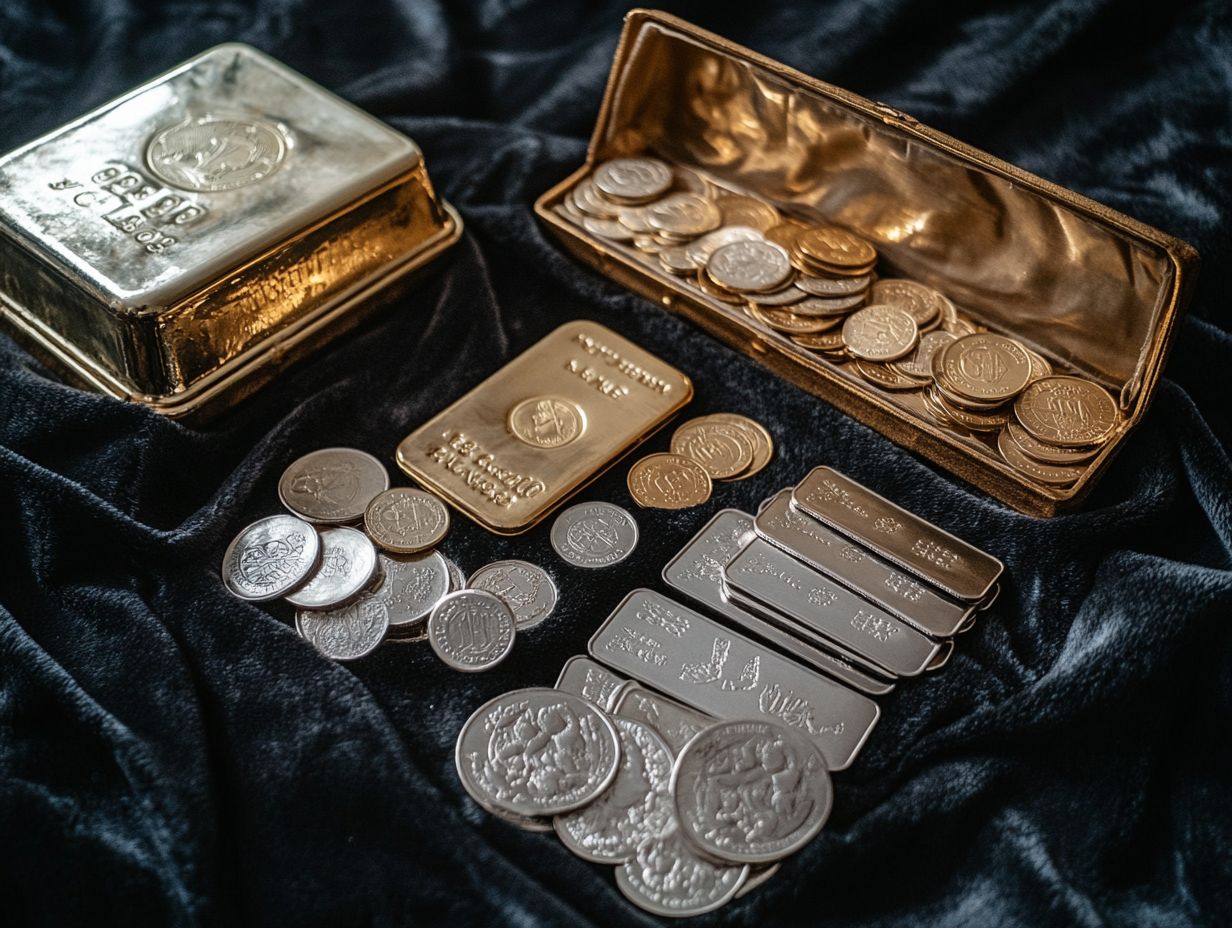How to Diversify with Precious Metals?
Investing in precious metals can be a smart strategy for diversifying your portfolio and protecting your wealth.
This article delves into the various types of precious metals at your disposal such as gold, silver, platinum, and palladium and emphasizes the advantages of weaving them into your investment tapestry.
You’ll explore essential factors to consider before making your move, from market trends to your personal financial goals. You’ll also evaluate different investment methods, whether through tangible assets or paper investments.
You ll discover valuable tips for navigating this distinctive market. Learn how to seamlessly integrate precious metals into your investment journey, making them a strategic asset along the way.
Contents
- Key Takeaways:
- Precious Metals as Investment Options
- Factors to Consider Before Investing
- Methods of Investing in Precious Metals
- Diversifying with Different Types of Precious Metals
- Tips for Successful Diversification
- Frequently Asked Questions
- Have you ever wondered what precious metals are?
- How can I diversify my portfolio with precious metals?
- Why is it important to diversify with precious metals?
- What are the benefits of diversifying with precious metals?
- What are the risks associated with diversifying with precious metals?
- Are there any tax implications when diversifying with precious metals?
Key Takeaways:

- Diversify wisely: Consider market trends, personal goals, and methods of investing before choosing to diversify with precious metals.
- Variety is key: Diversifying with different types of precious metals, such as gold, silver, platinum, and palladium, can help mitigate risks and maximize returns.
- Stay flexible: Regularly reassess and adjust your investments to ensure successful diversification across different markets and industries.
Precious Metals as Investment Options
Precious metals gold, silver, platinum, and palladium are a valuable part of any investment portfolio, especially in times of economic uncertainty. Their intrinsic value and historical role as a safe haven for wealth make them a wise choice.
As tangible assets, they serve as a robust hedge against inflation and currency fluctuations, enhancing your diversification strategy. Additionally, the interplay of scarcity and availability is crucial in shaping the ever-changing prices of these commodities, influenced by market trends and geopolitical developments.
Types of Precious Metals
When considering investments in precious metals, you’ll likely focus on the primary options: gold, silver, platinum, and palladium. Each metal presents unique characteristics and investment opportunities shaped by the dynamics of market demand and supply.
Gold, with its storied history as a reliable store of wealth, is a favored choice, often found in the form of bullion coins and bars. Its appeal tends to spike during times of economic uncertainty, positioning it as a safe-haven asset that many investors turn to for stability.
Silver stands out due to its wide-ranging industrial applications, from electronics to solar panels. This makes it a dual-purpose investment, functioning both as a precious metal and a critical ingredient in various manufacturing processes.
Platinum and palladium, while not as frequently highlighted, are vital components in automotive catalytic converters. They have attracted investors through channels like mining stocks and commodity ETFs, reflecting their increasing demand in the global market.
Benefits of Diversifying with Precious Metals
Diversifying your investments with precious metals can significantly enhance your portfolio. These assets can be your shield against inflation, safeguarding your financial security and contributing to long-term value.
Incorporating gold and silver into your investments offers distinct benefits. For example, gold typically maintains stability during economic turbulence, providing a dependable store of value. Meanwhile, silver, while more volatile, can yield higher returns during market upswings. To maximize your investment, consider following the best practices for precious metals investment.
You have several methods for investing, including purchasing physical metals, like bars and bullion coins, or choosing commodity exchange-traded funds (ETFs) that give you exposure to metal prices without the hassle of storage. If you’re interested in collectibles, investing in high-quality coins might also appeal to you. To enhance your strategy, consider learning how to diversify your precious metals portfolio.
By combining these elements, you create a diversified approach to risk management, making precious metals an attractive choice for protecting your wealth against market fluctuations and rising inflation.
Don t wait! Start exploring how precious metals can transform your investment journey today.
Factors to Consider Before Investing
Before you decide to invest in precious metals, it s essential to analyze several key factors. Consider market trends, economic uncertainty, and the risks tied to these investments.
Keep in mind that these elements can be influenced by monetary policies and political issues around the world. Taking a comprehensive approach will help you make informed decisions in this dynamic landscape.
Market Trends and Risks

Understanding market trends and risks is crucial when you venture into the precious metals market. Price fluctuations can stem from changes in global supply and demand dynamics. Various external economic factors can catch investors off guard.
Pay close attention to the current landscape for gold, silver, platinum, and palladium. Recent movements indicate a growing interest in these valuable commodities. Gold is proving to be a strong choice amid inflation worries! Silver continues to be favored for its industrial applications.
On the other hand, platinum is experiencing shifts due to a volatile automotive sector. Palladium remains in the spotlight for its critical role in catalytic converters.
Engaging in this market carries risks, including political issues around the world and unforeseen market shifts. To navigate these challenges effectively, stay informed through diligent market analysis. Diversify your portfolio wisely and carefully consider your investment strategy.
Personal Financial Goals
Aligning your precious metal investments with your personal financial goals is essential for crafting a robust investment portfolio. This will ensure long-term financial security and stability.
To seamlessly integrate these assets into your overall investment strategy, start by clearly defining your financial objectives. Whether your aim is growth, wealth preservation, or creating a buffer against inflation, this clarity will guide you in selecting the right types of precious metals, including understanding the role of silver in a diversified portfolio.
This gives you a solid framework for assessing risk and potential returns. By understanding your unique financial landscape, you can make informed decisions that align with your risk tolerance and market dynamics. Ultimately, this approach leads to a more resilient and diversified portfolio.
Methods of Investing in Precious Metals
You have a wealth of options when it comes to investing in precious metals, whether through physical assets or paper investments. Each approach offers distinct levels of security and liquidity, allowing you to tailor your investment strategy to best suit your goals.
Physical vs. Paper Investments
When you consider investing in precious metals, you must weigh the choice between physical metal and paper investments. Each presents its own set of advantages and challenges regarding security and market fluctuations.
Physical investments like gold bullion and silver coins provide a tangible asset that many believe offers superior security. They aren t burdened by counterparty risk the way paper assets can be. However, physical holdings come with their own drawbacks, such as storage concerns and insurance costs that might nibble away at your profits.
In contrast, paper investments like ETFs (Exchange-Traded Funds) and futures offer impressive liquidity and ease of trading. This allows quick and seamless entry and exit from the market. Yet, the volatility of these financial instruments can introduce risks, leaving you vulnerable to sharp market movements.
This makes it essential for you to have a clear understanding of your risk tolerance and investment strategy as you navigate these options.
Are you ready to explore the exciting world of precious metals?
Start your investment journey today or seek expert advice!
Individual vs. Group Investments
You can invest in precious metals either individually or through group investments, like mutual funds a type of investment where many people pool their money together to invest in various assets and mining stocks. Each path presents its own unique opportunities and risks, influenced by the dynamics of the chosen investment strategy.
Choosing individual investments gives you direct control over your assets. Imagine purchasing physical gold bars or silver coins, creating a tangible sense of ownership that many find appealing. However, managing these assets requires considerable knowledge and time, as well as secure storage. To enhance your investment strategy, consider learning how to diversify with gold investments.
On the other hand, group investments let you pool resources with others, resulting in improved diversification. This means you can easily access a wider variety of precious metals or mining projects without the hassle of direct management. For example, a mutual fund may offer shares in various mining companies, effectively spreading out risks while potentially boosting returns in a fluctuating market. Additionally, understanding tax strategies for precious metals can further enhance your investment approach.
Ultimately, both approaches have their advantages. Your decision should be guided by your personal preferences and investment goals.
Diversifying with Different Types of Precious Metals

Diversifying with a range of precious metals gold, silver, platinum, and palladium can help you achieve balanced exposure to the many market factors that influence their prices.
This strategic approach enhances your portfolio s resilience and elevates your overall investment diversification, allowing you to navigate market fluctuations with greater confidence.
Comparing Gold, Silver, Platinum, and Palladium
When comparing gold, silver, platinum, and palladium, you’ll find that each metal boasts unique qualities and investment opportunities. Their price fluctuations are influenced by various factors, such as industrial applications and market demand.
Consider silver; it s admired not just for its beauty but also for its critical role in multiple industries, including electronics and renewable energy. These factors can significantly influence its pricing dynamics. In contrast, palladium has surged in popularity due to its essential role in catalytic converters, devices in cars that reduce harmful emissions, making it sensitive to changes in automotive demand.
Gold and platinum, often seen as safe-haven assets, attract investors during economic uncertainty, as they seek to safeguard their wealth and hedge against inflation. Understanding gold’s role in a portfolio can provide valuable insights. The interplay of these various factors creates a complex landscape for anyone eager to navigate these markets.
Tips for Successful Diversification
Successful diversification in precious metals investing requires a strategic approach that considers market trends, the inherent risks associated with precious metals, and the importance of regularly reassessing your investments to optimize returns.
Diversifying Across Different Markets and Industries
To achieve effective diversification, consider spreading your investments across various markets and industries that utilize precious metals. This enhances your overall investment strategy in response to shifting economic trends.
Explore sectors such as automotive, where palladium is essential in catalytic converters, and the jewelry industry, which fuels gold demand. To enhance your investment strategy, learn how to diversify: physical vs. paper metals. This can help you craft a more resilient portfolio.
For example, fluctuations in the car manufacturing sector might lead to rising palladium prices, directly influencing your overall investment returns. Similarly, during economic booms when consumer confidence flourishes, the luxury goods market experiences a surge, driving up both demand and value for gold.
By leveraging the interdependencies among these diverse industries, you can effectively mitigate risks tied to reliance on a single sector, thereby safeguarding your financial future.
Regularly Reassessing and Adjusting Investments
Don t overlook the importance of regularly reassessing your investments! It s key to maintaining a strong portfolio, especially when market fluctuations threaten the value of precious metals.
This ongoing evaluation allows you to stay proactive. It ensures that unexpected changes don t take you by surprise.
It’s crucial to keep a close eye on specific indicators that might signal significant shifts in precious metal prices. Key market trends can offer valuable insights. For example, a surge in gold demand often points to economic uncertainty.
Fluctuations in interest rates or inflation can also affect how much people can buy and how they spend their money. Global issues, such as trade tensions or political instability, can introduce volatility to the markets, underscoring the importance of constant vigilance and knowledge-based decision making.
Frequently Asked Questions

Have you ever wondered what precious metals are?
Precious metals are valuable materials, like gold and silver, that are used in various industries and as investments.
How can I diversify my portfolio with precious metals?
You can diversify your portfolio with precious metals by investing in physical bullion, such as gold, silver, platinum, or palladium, or through exchange-traded funds (ETFs) that track the performance of these metals.
Why is it important to diversify with precious metals?
Diversifying with precious metals can help mitigate risk in your investment portfolio since their value is not directly correlated with traditional assets like stocks and bonds.
What are the benefits of diversifying with precious metals?
Diversifying with precious metals can provide protection against inflation, currency devaluation, and geopolitical uncertainty. It also offers potential long-term growth and diversification benefits for your portfolio.
What are the risks associated with diversifying with precious metals?
The main risks associated with diversifying with precious metals include fluctuations in market prices, potential liquidity issues, and the possibility of fraud or counterfeit products.
Are there any tax implications when diversifying with precious metals?
The tax implications of diversifying with precious metals vary depending on the specific metal, the form of investment, and the individual’s tax situation. It is recommended to consult with a tax professional for personalized advice.














